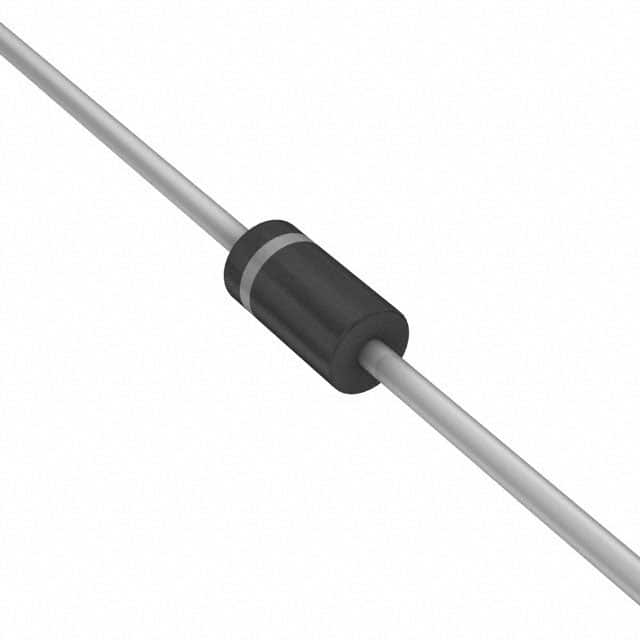Consulte las especificaciones para obtener detalles del producto.

1N914B Diode
Product Overview
Category:
The 1N914B is a small signal diode used in electronic circuits.
Use:
It is commonly used for general-purpose switching and amplification applications.
Characteristics:
- Small size
- Fast switching speed
- Low forward voltage drop
Package:
The 1N914B is typically available in a DO-35 package.
Essence:
This diode is essential for controlling the flow of current in electronic circuits.
Packaging/Quantity:
It is usually sold in reels or packs of 100 pieces.
Specifications
- Maximum repetitive peak reverse voltage: 100V
- Average rectified forward current: 75mA
- Forward voltage drop: 1V at 10mA
Detailed Pin Configuration
The 1N914B diode has two pins, anode, and cathode. The anode is connected to the positive side of the circuit, while the cathode is connected to the negative side.
Functional Features
- Fast switching speed allows for rapid response in electronic circuits.
- Low forward voltage drop minimizes power loss in the circuit.
Advantages
- Small size makes it suitable for compact circuit designs.
- Fast switching speed enables efficient signal processing.
Disadvantages
- Limited maximum repetitive peak reverse voltage compared to other diodes.
- Relatively low average rectified forward current capacity.
Working Principles
The 1N914B diode operates based on the principle of semiconductor junction behavior. When a forward voltage is applied, it allows current to flow, while in reverse bias, it blocks the current flow.
Detailed Application Field Plans
Audio Amplification
The 1N914B diode can be used in audio amplifier circuits for signal processing and amplification.
Signal Rectification
It is suitable for converting alternating current (AC) signals to direct current (DC) in rectifier circuits.
Switching Circuits
Due to its fast switching speed, it is commonly used in electronic switching circuits.
Detailed and Complete Alternative Models
- 1N4148: Similar small signal diode with higher maximum repetitive peak reverse voltage.
- 1N4001: General-purpose rectifier diode with higher average rectified forward current capacity.
In conclusion, the 1N914B diode is a versatile component widely used in various electronic applications due to its small size, fast switching speed, and low forward voltage drop. While it has limitations in terms of maximum voltage and current handling, it remains a popular choice for many circuit designs.
[Word Count: 346]
Enumere 10 preguntas y respuestas comunes relacionadas con la aplicación de 1N914B en soluciones técnicas
What is the 1N914B diode used for?
- The 1N914B diode is commonly used for general-purpose switching and signal applications.
What are the key specifications of the 1N914B diode?
- The 1N914B diode typically has a maximum repetitive peak reverse voltage of 100V, a forward continuous current of 75mA, and a forward voltage drop of around 0.6V at 10mA.
Can the 1N914B diode be used in high-frequency applications?
- Yes, the 1N914B diode can be used in high-frequency applications due to its fast switching speed and low capacitance.
How does the 1N914B diode compare to other similar diodes?
- The 1N914B diode is similar to the 1N4148 diode, with slightly different electrical characteristics. It is also comparable to the 1N4448 diode, which has similar performance but is designed for higher voltage applications.
What are some common circuit configurations using the 1N914B diode?
- The 1N914B diode is often used in rectifier circuits, clipping circuits, and as a general-purpose signal diode in various electronic devices.
Can the 1N914B diode handle high temperatures?
- The 1N914B diode has a maximum operating temperature of around 175°C, making it suitable for many standard electronic applications.
Are there any special considerations when using the 1N914B diode in a circuit?
- It's important to consider the forward voltage drop and reverse leakage current when designing circuits with the 1N914B diode to ensure proper functionality.
What are the typical applications where the 1N914B diode is commonly used?
- The 1N914B diode is frequently used in audio amplifiers, radio frequency (RF) circuits, digital logic circuits, and general electronic equipment.
Can the 1N914B diode be used for voltage regulation?
- While the 1N914B diode is not typically used for voltage regulation, it can be employed in certain voltage reference and limiting circuits.
Is the 1N914B diode suitable for use in low-power applications?
- Yes, the 1N914B diode is well-suited for low-power applications due to its low forward voltage drop and moderate current handling capabilities.

